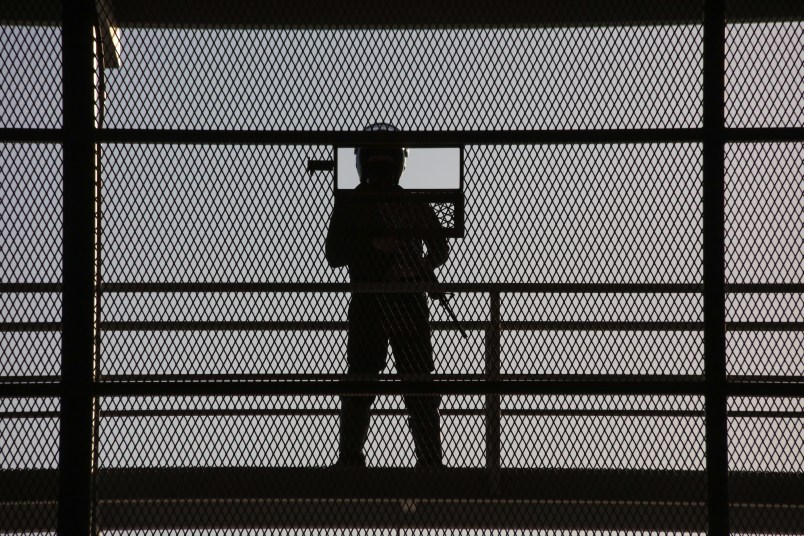When the Trump administration sent more than 200 Venezuelans to an El Salvador detention camp last month, nearly half of them were subject to standard immigration law.
That, at least, is what federal officials contend: while the administration invoked the Alien Enemies Act to dubiously justify sending 137 detainees to El Salvador, more than 100 others that day had received standard, lawful deportation orders — often to Venezuela — from immigration courts.
In these cases, the administration invoked standard immigration authority to hold Venezuelans indefinitely in CECOT, a Salvadoran detention facility notorious for allegations of forced labor and torture. The move, done under a bilateral agreement with El Salvador, has left detainees incommunicado and held without charge — and their families and attorneys fighting for their release.
The cases present a kafkaesque situation. The government did not remove these Venezuelans under the wartime Alien Enemies Act, which the administration argued allowed it to send people to CECOT absent due process, an argument the Supreme Court would later reject. Rather, the administration has contended in court filings that these individuals were sent to El Salvador under the Immigration and Nationality Act. That’s in some tension with the result: that they were sent to a prison that is neither in the U.S. nor their country of origin with no charges and no clear legal authority justifying their continued, indefinite detention. The U.S. government is paying El Salvador to hold them.
The result, relatives and advocates for those detained told TPM, is indefinite confinement in a foreign country for people accused of being undocumented immigrants, raising due process questions separate from those that persist for those removed under the Alien Enemies Act. The question at the core of this — are these detainees in the custody of the United States, or El Salvador? — now features in at least two habeas corpus lawsuits filed on behalf of those removed.
“This is a question that the federal courts are going to have to resolve,” César Cuauhtémoc García Hernández, a professor of criminal and immigration law at Ohio State University, told TPM. “We’re in unprecedented territory here.”
In one of the cases, national immigration nonprofits representing a detainee accuse the government of unlawful detention under color of law, among other claims.
TPM identified a second, previously unreported lawsuit brought by the wife of an undocumented, Venezuelan-born New York City man. Gloria Browning Vaamondes Barrios filed a pro se lawsuit in federal court in Brooklyn on behalf of her husband, Miguel Vaamondes Barrios, who was removed to El Salvador on March 15.
U.S. Immigration and Customs Enforcement did not return a request for comment.
Two lawsuits
Vaamondes Barrios knew something had gone wrong when she saw on the news that the Trump administration and sent three flights of deportees to El Salvador, potentially in defiance of a judge’s order.
She had spent days speaking with her husband, Miguel Vaamondes Barrios, tracking him as the government moved him from Pennsylvania to El Paso, Texas, to Webb County Detention Facility in Laredo. She spoke with him from her home in Brooklyn, New York hours before he was removed.
“He told me he was going to call me when he landed in Venezuela,” Vaamondes Barrios recalled of a conversation on March 14. He later said that the bus he was on to the airport had turned around on the way. “I think they’re playing games,” she recalled Miguel saying.
The next day, she saw the news. “I waited, waited for him, and then I see on the news that Venezuelans landed in El Salvador,” she said. “And I just knew it was him.”
Vaamondes Barrios hasn’t heard from her husband since. His name appeared on a list of Venezuelans sent to CECOT published by CBS News in the days after the removals.
Vaamondes Barrios was one of those deportees removed through what the Trump administration contends were normal immigration processes, not under the Alien Enemies Act. Per a copy of a deportation order reviewed by TPM, an immigration judge ordered Miguel Vaamondes Barrios removed to Venezuela in December 2024.
Miguel entered the United States in 2021, Gloria told TPM. He’s had a few run-ins with the law: in 2023, he was charged in Pennsylvania with retail theft. The New York Post called Vaamondes Barrios a “migrant squatter” in a story last year after he was arrested at a building in the Bronx while police were investigating a report of a man with a gun; a weapons possession charge was later dropped.
In some ways, he exemplifies how the administration’s plan to indefinitely confine people in a Salvadoran detention camp flattens the complexity of each case. Miguel Vaamondes Barrios had agreed to be removed to Venezuela, per documents reviewed by TPM, and agreed to withdraw an asylum claim.
Because the government sent him to CECOT, there remains an open question about whose custody he is in and who can secure his release. Gloria Vaamondes Barrios has sought legal counsel, but is proceeding pro se in a habeas lawsuit she brought in Brooklyn federal court on March 31.
It’s similar to another suit brought on behalf of another Venezuelan CECOT detainee named Edicson David Quintero Chacón. In that case, Quintero Chacón initially filed a pro se lawsuit in the Middle District of Georgia.
Then, attorneys with the American Immigration Council, the National Immigration Project, and Center for Constitutional Rights joined and filed a new complaint, accusing the Trump administration of violating Quintero Chacón’s habeas corpus rights by detaining him without charge in El Salvador, and for unlawfully detaining him under color of law.
“What this case really hinges on is the notion that even though … he’s physically in El Salvador, the U.S. government is controlling that custody,” Rebecca Cassler, an attorney with the American Immigration Council on the case, told TPM.
“The government is controlling that custody,” she continued. “They’ve signed a contract with the Salvadoran government to detain people there. So what we’re arguing in this case is that the U.S. government is still the de facto custodian of Mr. Quintero and all of the people there.”
Whose custody?
The last time the courts had to explore similar questions around habeas came in the years after 9/11.
The Bush administration had launched the Global War on Terror, saying that it would leverage diplomatic relationships and the vast reach of the country’s military and intelligence apparatuses to pursue Islamic extremists around the globe. In practice, it meant a lot of overreach, errors and, in some cases, boundary-pushing, legally dubious efforts to keep targets out of the reach of American legal protections.
One case from that era ended up, if only briefly, testing the same principle at stake in the El Salvador habeas removals. In 2003, a U.S. citizen named Ahmed Abu Ali was arrested in Saudi Arabia and held there without charge. During his detention, FBI officials purportedly watched as Abu Ali was interrogated.
Abu Ali’s parents filed a habeas corpus lawsuit in D.C., saying that the U.S. was using the Saudi government as an intermediary to detain their son. A district judge agreed, finding that he had jurisdiction to determine if the habeas claim was true.
Beyond that, experts TPM spoke with said that the issue remains mostly academic. The question of whose custody the deportees are in — both those removed under the Alien Enemies Act and those removed under normal immigration law — will come down in part to records that may be pried loose through litigation, including agreements between the U.S. and El Salvador, or statements from administration officials.
“What’s unusual here is that there is this standing contractual agreement between El Salvador and the United States to accept seemingly anyone into this prison at the behest of the U.S. federal government,” García Hernández, the Ohio state professor, told TPM.
Whether that’s unusual enough to compel the detainees’ release is another question.
This story was updated to add details about Quintero Chacón’s lawsuit.











If the questions being addressed in these lawsuits were purely academic, it would be fascinating.
The fact that in a matter of months the current administration has sought out and repeatedly made use of tactics that (while obviously morally repugnant) lack clear legal definition is a demonstration of its desire to weaponize the law against the citizenry. Justice delayed is justice denied is all the more true when the administration is actively seeking decisions through appeals all the way to SCotUS which fly in the face of the ideals the nation should be attempting to live up to.
The attorneys willing to stand up in court and defend such tactics should face disciplinary hearings and disbarment.
There is a simple solution, stop paying El Salvador and the believe me these men will be on the next plane back here.
The Trump Administration, better known as Thugocracy, Inc.
Going back to at least mid-March, immigrants in ICE custody disappear, including from the ICE online locator.
And it continues
Even yesterday
He disappeared after detention. Now ICE is silent on the fate of Venezuelan man
Interestingly enough, this has been going on since 2021 at least - when Biden tightened the border (no, really, just never reported) and invested more on border security than president Trump, with a Customs and Border Protection (CBP) and ICE combined of $26 billion. (No, really. just never…you get it). Detentions skyrocketed. And people in detention were disappeared.
It seems like ICE has been developing this skill for some time now.
This kind of thing is very useful in user testing software. You get creative people attempting to break the program by working the user interface in unanticipated, often apparently stupid ways.
Sadly, the US laws and Constitution are not easily changed, like lines of code are, and rather than being a systematic attempt to learn by experience and improve the software, there’s just haphazard, knee jerk, and over compensatory modifications at rare intervals. Mostly, no lessons are ever learned, except by the “black team”, which is part of the coding team and wants to preserve its back doors.